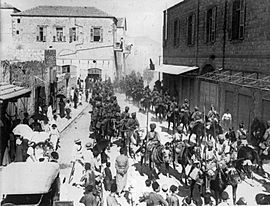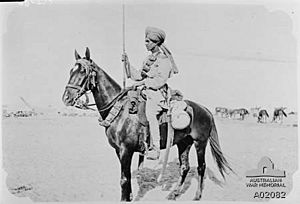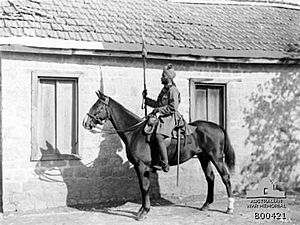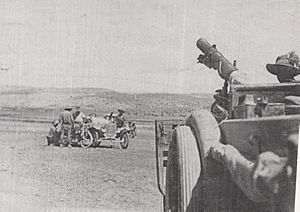Battle of Haifa (1918) facts for kids
Quick facts for kids Battle of Haifa |
|||||||||
|---|---|---|---|---|---|---|---|---|---|
| Part of the Middle Eastern theatre of World War I | |||||||||
 Jodhpur lancers marching through Haifa after it was captured |
|||||||||
|
|||||||||
| Belligerents | |||||||||
|
|||||||||
| Commanders and leaders | |||||||||
| Unknown | |||||||||
| Units involved | |||||||||
| 15th (Imperial Service) Cavalry Brigade | Haifa garrison | ||||||||
| Casualties and losses | |||||||||
| 8 Indians killed 34 Indians wounded |
Unknown killed and wounded Prisoners 2 German officers 23 Ottoman officers 664 other ranks total: 1,350 prisoners |
||||||||
The Battle of Haifa was a key fight during World War I. It happened on September 23, 1918. This battle was part of a larger series of fights called the Battle of Megiddo. This big battle took place in the last months of the Sinai and Palestine Campaign.
During the Battle of Haifa, soldiers from British India played a major role. The 15th (Imperial Service) Cavalry Brigade attacked the forces of the Ottoman Empire. This led to the capture of the important towns of Haifa and Acre. These towns are in what is now Israel. The attack happened near the Jezreel Valley, about 40 to 50 miles from Sharon.
The Battle of Megiddo started with British Empire soldiers attacking. They pushed back the Ottoman front line. British cavalry then moved quickly through gaps in the enemy lines. This helped to surround many Ottoman soldiers. By September 25, one Ottoman army was defeated. The rest were retreating north towards Damascus.
The 5th Cavalry Division was given the job of capturing Haifa and Acre. Earlier attempts had failed because of strong enemy defenses. A group of soldiers from the Mysore Lancers and Sherwood Rangers Yeomanry attacked first. They went after an Austrian artillery battery. Then, the Jodhpur Lancers and a light car patrol joined in. They attacked the main German defenses and captured Haifa. This victory is still celebrated every year on September 23 as Haifa Day.
Contents
Why Haifa Was Important
The 5th Cavalry Division was a strong fighting group. It had three brigades. Two brigades included British soldiers and two British Indian Army cavalry regiments. The third brigade was the 15th (Imperial Service) Cavalry Brigade. This brigade had cavalry regiments from Indian Princely States. These states included Jodhpur, Mysore, and Hyderabad. The division also had machine guns, artillery, and armored cars.
After earlier victories, the Ottoman armies were in trouble. Their main headquarters lost contact with its armies. The British forces controlled all direct routes north. This forced the Ottoman armies to retreat on smaller roads. They went east across the Jordan River. Capturing Haifa was very important for the British. The roads to the port were not good. Taking Haifa meant supplies could be brought in by sea. This was needed for the British to keep moving forward.
Getting Ready for Battle
Early on September 22, the 18th King George's Own Lancers were moving towards Acre. They were attacked by Ottoman soldiers from Haifa. The Lancers quickly defeated them. They caused 30 casualties and captured over 200 prisoners.
Later, a plane reported that the Ottoman army had left Haifa. But this was wrong. When British forces tried to enter Haifa, they were met with strong fire. Ottoman artillery and machine guns stopped them. Armored cars found a strong enemy position near the road to Haifa. This position had machine guns and artillery on the slopes of Mount Carmel. The armored cars fired on the position, and it quickly surrendered.
Further on, they found an Austrian battery of light guns. German machine gunners supported these guns. This strong position blocked the road. It was hard to go around because of marshes near the Nahr el Mugatta river. So, the 5th Cavalry Division was ordered to capture Haifa and Acre the next day.
The Battle Begins
On September 23, 1918, the 15th (Imperial Service) Cavalry Brigade got orders to take Haifa. The area between the Kishon River and Mount Carmel was well defended. Ottoman guns and artillery were placed there. The Jodhpur Lancers were given the task of capturing this area. The Mysore Lancers would attack the town from the east and north.
At 2:00 PM, a group of Mysore Lancers and Sherwood Rangers Yeomanry attacked. They were supported by artillery. They went after the Austrian guns on Mount Carmel. The Mysore Lancers climbed a steep path to silence the guns. Meanwhile, the Jodhpur Lancers began their main attack. They charged the German machine gunners who blocked the road.
The Jodhpur Lancers charged across the Acre railway line. But they faced heavy machine gun and artillery fire. The charge was also slowed by quicksand near the river. So, they moved to the left, onto the lower slopes of Mount Carmel. The regiment secured this position. They captured thirty prisoners and several guns. This opened a path into Haifa.
The Jodhpur Lancers continued their charge right into the town. This surprised the defenders. The Mysore Lancers, who had been helping with fire, then rode into the town too. Together, the two regiments captured many prisoners. This included 1,350 German and Ottoman soldiers. They also took 17 artillery guns and 11 machine guns. The Indian soldiers had 8 killed and 34 wounded. Many horses were also killed or injured.
We tried to cover the Turks’ retreat, but we expected them to do something, if only keep their heads. At last we decided they were not worth fighting for.
After the Battle
Soon after, the 13th Cavalry Brigade captured Acre, a town to the north. They took 150 prisoners and two artillery guns there. On September 26, the remaining soldiers from the Haifa defense arrived in Beirut. They were then ordered to move inland.
General Allenby reported on September 25 about the battle. He mentioned that over 40,000 prisoners had been taken. He planned to send three divisions of cavalry to Damascus. He hoped that if Damascus was captured, Beirut would also fall. He also planned to move troops north from Haifa by the coast road.
By September 29, the 7th (Meerut) Division was in Haifa. They were getting ready to march to Beirut. Major Dalpat Singh, the commander of the Jodhpur Lancers, was killed in the battle. He was given the Military Cross award after his death. The Jodhpur and Mysore Lancers are now part of the 61st Cavalry Regiment in the Indian Army. They still remember the battle every year on September 23 as Haifa Day.
Images for kids








